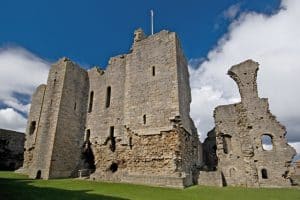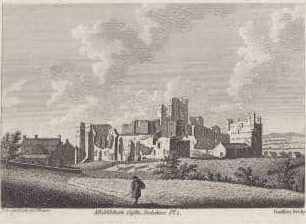Middleham Castle
Middleham Castle is situated in Wensleydale, North Yorkshire. The castle was hugely important in the Wars of the Roses and the years leading up to the outbreak of war. Held by the branch of the Neville family who supported the Duke of York, it was a site of planning and array. Middleham was the place to which the Earl of Warwick sent King Edward IV following his capture in the days following the Battle of Edgcote. Many major figures from the period have close links with the castle at Middleham. For example it was a childhood home of the future King Richard III.

Origins of Middleham Castle
There are no remaining written records of the earliest Castle or fortification at Middleham. There is, however, archaeological evidence that a structure was built before the one that is visible today. An earlier castle has been located on ‘William’s Hill’. This was a timber construction with earthworks around it. As such it is of a design similar to other post Norman Conquest constructions. A quickly built but effective Motte and Bailey type structure. In the post Conquest era, the area had been granted to Alan Rufus, one of the Conquerors cousins. Its location in the heart of Yorkshire places it in the middle of a region in which resistance was crushed through the ‘Harrying’ of the North. Other than the archaeological remains at William’s Hill though, there is little evidence of Middleham’s importance under the Normans.
Development of Middleham Castle
12th Century Keep
The Stone Keep that remains to this day is believed to have been constructed in the 1170s. Written evidence for the site dates from 1216 but clues on the building allow it to be dated with reasonable confidence. Those clues are not visible to visitors but within the Keep there are carvings that were only used within a relatively short period of time. The Keep was expanded in the early 13th century with the tower on the eastern side of the fortification being added.
Ranulph 3rd Baron Neville of Raby and the Curtain Walls at Middleham
Middleham Castle became a property held by the Neville’s of Raby in 1258. Robert 2nd Baron Neville of Raby married Mary fitz Ranulph an heiress whose lands included Middleham. Under Neville hands the Castle at Middleham was to grow into a far more formiable structure. Curtain walls were soon added to the castle. It is believed these were added by Ranulph, 3rd Baron Neville of Raby in the early 14th century.
Ralph Neville, 1st Earl of Westmorland and development of Middleham Castle into a palatial home
Under the control of Ralph Neville, 1st Earl of Westmorland, Middleham grew in stature and size. The Earl secured the rights to a weekly market and annual fair for Middleham. This made it an economic hub of greater value. From 1397 he also expanded the residential quarters within the castle and made them more comfortable. Ralph had the curtain walls raised and the tower to the north east was altered to become the main gatehouse to Middleham Castle. These were major works which incorporated extra toilet facilities. The improvements were most likely supervised by Master Mason John Lewyn. Lewyn also supervised construction of Bolton Castle in Wensleydale.

Middleham Castle as home of the Neville Family
Richard Neville 5th Earl of Salisbury turned Middleham Castle into the family home of the branch of the family that he headed. This period saw the castle expand once more. Parts of the keep were heightened, the north east tower of the curtain wall was developed and the chapel was upgraded. Much of the focus of the Earl of Salisbury’s castle developments were to improve the level of comfort within the castle.
Military base for the Neville Family
Middleham’s military strength was also of great importance at the time. Not only were there ever present threats from the Scots but there was also the Percy-Neville feud ensuing at the time. That feud meant that strongholds such as Middleham Castle and Sheriff Hutton needed to be well maintained. They also needed to be strong enough to repel potential assaults, and capable of being staging posts for attacks. Similarly, when the Wars of the Roses broke out, Middleham Castle was a site from which Neville retainers marched. For example, to Ludlow in 1459 which saw the Earl’s force engage and defeat a Lancastrian force at Blore Heath en route.

A home for Royalty
Middleham Castle has a rich history of Royal connections. The Neville family themselves were related to the Royal family as Joan Beaufort was a half-sister of King Henry IV. Thus the Neville line fstemming from her marriage to Ralph Neville 1st Earl of Westmorland was related, to some degree, to the Lancastrian kings. King Henry IV himself stayed at Middleham Castle in 1410. This was part of a progress through the north that followed the last of the Percy rebellions. The links to the Crown grew in the years that followed.
Childhood home of Royals
The Earls of Salisbury and his son the Earl of Warwick both used Middleham as a primary residence for the family in their northern lands. As a result, the dauhters of the Earl of Warwick, Anne and Isabel Neville, both spent time in the castle during their childhoods: both were born at Warwick Castle. At around the same time, Richard (later King Richard III) son of Richard 3rd Duke of York and Cecily Neville, was sent to Middleham Castle to be raised safely in his cousins household.
Middleham as a Royal gaol
During the Wars of the Roses Middleham Castle remained a mainstay of Neville might in the north. So much so that when the Earl of Warwick and Duke of Clarence rebelled in 1469, they chose Middleham as the place to send King Edward IV. Edward was essentially under house arrest at Middleham for a period of time, whilst the Earl and Duke attempted to rule in his name.
Richard Duke of Gloucester and Middleham Castle
Following the Yorkist resumption of power in 1471, Middleham Castle again became linked to Richard Duke of Gloucester. As Richard’s land holdings in the north grew, he used Middleham as a base. His various roles culminated in the Lieutenancy of the North and control of the Council of the North. So too was he placed in command of King Edward IV’s army that was to invade Scotland in 1482. Some of the work involved in the planning and execution of these roles took place at Middleham Castle. [Much was also run through the City of York].
Prince Edward (of Middleham)
Middleham Castle was also where the son of Richard and Anne Neville was born. Edward of Middleham was to become Prince of Wales upon his father’s accession. The young Prince predeceased his parents. His childhood at Middleham Castle did result in many documents being produced linked to Middleham that have survived. Some of those are summarised in this blog post on the nerdalicious website: A Glimpse of Edward of Middleham, Prince of Wales
Middleham Castle in the Tudor Era
Following Richard III’s death in the Battle of Bosworth, Middleham Castle became part of the Crown Estate under King Henry VII. The castle was maintained for some time. Records show that maintenance was updertaken in 1531. However by 1538 it was in a state of disrepair and the portcullis had been removed.
Post Tudor uses of Middleham Castle
The castle was sold by the crown until 1604. During the Civil Wars it was ordered that the castle be made ineffective as a defensive structure: an order which clearly wasn’t carried out. It was garrisoned in the 1650s and used to house Royalist prisoners during the period of Civil Wars.
Upon the restoration of Charles II in 1660 Middleham Castle was once again sold. Since then the castle has been suggested as a place in which to house prisoners of war but fell out of day to day usage and consequently fell into disrepair.
Middleham Castle Links
English Heritage– Middleham Castle.
Historic England – official listing for Middleham Castle.
North Yorkshire County Council – the council’s guide to the castle, useful for visitor information.
History Hit – short video about the castle.
CastleUk.net – Middleham Castle
Featured Image
‘Middleham Castle, Yorkshire. Pl 1. Pub: 1 April 1785 by S. Hooper Godfrey Sculp. Item digitised from the collection of the University of Leicester Centre for Regional and Local History. (CC BY-NC 4.0)
